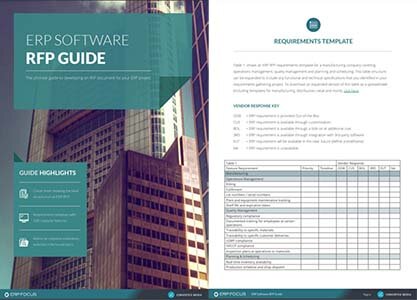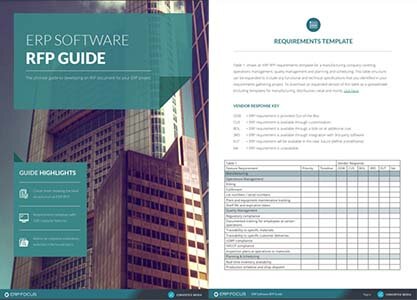4 pieces of essential ERP documentation you should understand
Once you begin the delve into the realm of ERP requirements gathering, selection and implementation, a whole wealth documentation will be recommended to you. That is why we thought it worthwhile creating a brief introduction to some of the commonly sought after ERP documentation.
GET ERP RESEARCH & KNOWLEDGE RIGHT TO YOUR INBOX
Covering the key issues faced by businesses selecting and implementing ERP.
1. ERP requirements document
What is the most essential piece of ERP documentation? In my opinion, number one is your internal ERP document describing how this powerful tool is going to help your organization. It will include your goals and how you plan to measure attainment. It also will include your hopes that might not be so easily measured. You will include risks and costs you anticipate or need to keep in mind as you implement your ERP.
Spend plenty of time developing this ERP requirements document, and be sure to accept changes and updates throughout your ERP implementation.
Guide: ERP request for proposal
2. ERP RFI and RFP
Use your internal document to develop a request for information (RFI) or a request for proposal (RFP) from potential ERP vendors. They should be aware of significant constraints or requirements. Some of them might tell you your concerns are not a problem. They should have more experience in ERP systems than you have so they could be right but the decisions are yours.
3. ERP RFQ and contract
After your evaluations of the potential vendors, you will select one and now comes the time to agree on terms. Who will be responsible for what and by when? What guarantees are included and what is not guaranteed? What ongoing maintenance is included and what will additional maintenance cost? Will the vendor agree to performance clauses? What customization is included? Will the vendor develop an initial set of reports and dashboards to get you up and running quickly? Your contract will be the piece of ERP documentation which should answer any and every question that you or your ERP vendor may have.
These are important legal documents. Get your attorney involved from the beginning to ensure your business’ needs are well represented. You don’t plan on an adversarial turn but it could happen.
4. ERP implementation plan
Now the implementation begins and we return to your internal document. You have your goals set along with measurements and a time line. Your vendor should help develop a detailed ERP implementation plan. That plan will include testing your processes against the new ERP. It will also include converting your existing data from whatever its current form into the new ERP. You will develop a training plan. Then at the end, you will have user guides to help your staff meet their goals through the new ERP tool.
Testing, data conversion, and training all work together in an iterative process. Your tests will prove out the data conversion and often reveal some missing data not yet converted. The tests are also a tool to develop key users and allow them to begin training. Keep detailed records of your tests and the issues revealed.
Most of today’s ERPs allow you to publish your user guide within the ‘help’ section of the ERP. Use that capability. It is easy for users to find and is much more valuable than canned helps developed by programmers. Look for a wiki style so your staff can keep this ERP documentation up to date and continually improving.
Last and certainly not least - Measure the results. Does this tool provide the benefits you wanted?
Free white paper

ERP Software RFP Guide & Template
The comprehensive guide to developing an RFP document for your ERP project

Featured white papers
-

ERP Implementation: 9 steps to success
The 9 proven steps you should follow when implementing ERP
Download -

ERP Implementation Checklist
Over 120 actionable steps to implementing a new ERP successfully
Download -

Manufacturing ERP Implementation Checklist
Over 70 actionable steps to rolling out new manufacturing ERP software
Download
Related articles
-

The case for multi-tier ERP implementations
Learn more about multi-tier ERP implementation and why you might need one
-

CMMC Compliance: What Aerospace and Defense Manufacturers Need to Know
Key insights on CMMC compliance, deadlines, and securing DoD contracts with CMMC 2.0 certificatio...
-

An example ERP implementation team structure for your project
Learn about three key elements of an ERP implementation team and the individuals who contribute w...

